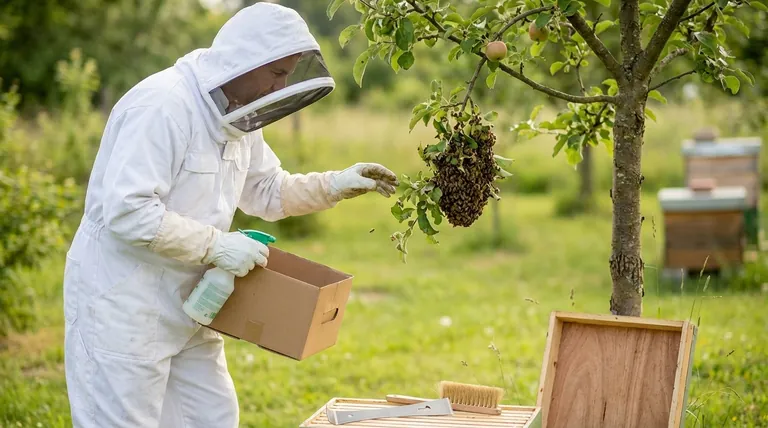Yes, but with critical caveats. Catching a swarm can be an exhilarating and rewarding experience for a new beekeeper, and it is often considered a rite of passage. However, your success and safety depend entirely on the specific situation, your level of preparation, and your ability to remain calm. It is not a task to be undertaken lightly or without a clear understanding of the process.
Catching a swarm is less about complex technique and more about proper risk assessment. For a beginner, the decision to proceed should be based on the accessibility of the swarm and your personal preparedness, not just the allure of "free bees."

The Mindset of a Swarm
Before attempting a capture, you must understand the state of the bees you are approaching. This knowledge is the foundation of your safety and success.
The Nature of a Traveling Swarm
A swarm is a natural part of the honey bee life cycle. The old queen leaves the hive with roughly half the colony's bees to find a new home, leaving a new queen to take over the original hive.
Bees in a swarm are typically at their most docile. They have gorged on honey before leaving and have no home, brood, or food stores to defend. Their primary focus is protecting the queen and finding a suitable new cavity.
Swarm vs. Established Colony
It is critical to distinguish between a swarm and an established colony. A swarm is a temporary cluster of bees, often hanging from a branch or fence post while scout bees search for a permanent home.
A group of bees flying in and out of a hole in a wall, an attic, or a compost bin is an established colony. Attempting to remove this is a "cut-out," a far more complex and dangerous job that is not suitable for beginners.
Your Go/No-Go Checklist
Never approach a swarm without first running through a mental checklist. If you cannot answer "yes" to the first two points, your best move is to call for help.
Is the Swarm Easily Accessible?
This is the single most important question. An ideal first swarm is hanging on a low branch or bush, somewhere between waist and shoulder height.
If the swarm is high up in a tree, on a utility pole, or near power lines, do not attempt the capture. The risk of falling from a ladder is far greater than the risk of being stung.
Do You Have the Right Equipment?
Having the minimum necessary equipment is non-negotiable. You will need:
- Full Protective Suit: A full bee suit with a veil and gloves is essential for safety and confidence.
- A Collection Box: A cardboard "nuc" box, a spare hive body, or even a sturdy bucket is needed to place the bees into.
- A Spray Bottle: Filled with a 1:1 sugar water solution, this helps calm the bees and encourages them to cluster together.
- A Soft Brush: To gently sweep remaining bees into your container.
Do You Have a Mentor on Standby?
Confidence comes from knowing you have a backup. Before you begin, ensure you have the phone number of an experienced beekeeper or a local swarm removal list. A quick call can provide critical advice if you encounter something unexpected.
Understanding the Risks and Trade-offs
Objectivity requires acknowledging that things can go wrong. Understanding the risks allows you to prepare for them.
Risk of Agitation
While typically docile, a swarm can become defensive. If you are clumsy, drop the branch, or accidentally crush the queen, the bees' behavior can change instantly. This is why full protective gear is mandatory.
Risk of Absconding
Success is not guaranteed. You may capture the bulk of the bees, only to have them leave the box and return to the cluster spot if the queen was not collected. The entire swarm might also decide to take flight just as you are working. Do not view this as a personal failure; it is simply bee behavior.
Risk of Disease and Mites
A wild swarm is an unknown quantity. It could be perfectly healthy, or it could be carrying a heavy load of Varroa mites or other diseases. Any swarm you capture should be kept separate from your existing colonies (quarantined) and monitored or treated for mites before being integrated into your apiary.
How to Apply This to Your First Capture
Your decision should be guided by a conservative assessment of the situation and your preparedness.
- If the swarm is low, on a simple branch, and you have all your gear: This is the perfect scenario for a beginner. Proceed calmly and deliberately.
- If the swarm requires a ladder or is in a tricky spot (like a dense thicket): Your first action should be to call a mentor for assistance. This can become a valuable learning experience with an expert by your side.
- If the bees are entering any part of a structure: Do not proceed. This is a cut-out, not a swarm capture. Contact a professional bee removal service.
Ultimately, your goal as a new beekeeper is to build confidence and competence through safe, successful experiences.
Summary Table:
| Assessment Factor | Beginner Recommendation |
|---|---|
| Swarm Location | Proceed if low & accessible (e.g., low branch). Avoid if high or near power lines. |
| Swarm Type | Proceed only for temporary clusters (swarms). Avoid established colonies in structures. |
| Required Gear | Full bee suit, nuc box, spray bottle, soft brush. Do not attempt without proper equipment. |
| Mentor Support | Highly recommended. Have an experienced beekeeper on standby for advice. |
Ready to confidently start your beekeeping journey with the right equipment?
At HONESTBEE, we supply commercial apiaries and beekeeping equipment distributors with the durable, reliable gear essential for safe beekeeping operations—from full protective suits to swarm collection boxes. Let us help you build your apiary with professional-grade supplies.
Contact our expert team today to discuss your beekeeping supply needs!
Visual Guide

Related Products
- HONESTBEE Professional Long Handled Hive Tool with Precision Cutting Blade
- Professional Dual-End Stainless Steel Hive Tool for Beekeeping
- HONESTBEE Professional Multi-Functional Hive Tool with Ergonomic Wood Handle
- Multi-Function Plier-Style Frame Grip Hive Tool
- Professional Stainless Steel Pry-Bar Hive Tool
People Also Ask
- What are the features of a regular hive tool? The Essential Multi-Tool for Every Beekeeper
- How can a hive tool be used to remove propolis and burr comb? Master Hive Maintenance for a Healthy Colony
- What are some common uses of a hive tool? Essential Multi-Purpose Tool for Every Beekeeper
- How should beekeepers handle bees when using a hive tool? Master Calm, Deliberate Techniques
- What tools are used for cleaning frames? A Beekeeper's Simple 4-Tool Guide



















